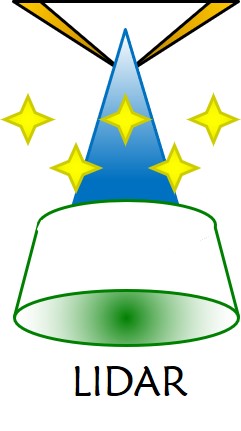Lidar Emitter and Multispecies greenhouse gases Observation instrument
LEMON will provide a new versatile Differential Absorption Lidar (DIAL) sensor concept for greenhouse gases and water vapour measurements from space (https://lemon-dial-project.eu/).

Within the framework of the European Lemon programme coordinated by ONERA, an unprecedented field experiment took place over the Ardèche from the Aubenas airfield. The main objective of this field scientific experiment was to characterise a new DIAL lidar instrumentation dedicated to the measurement of atmospheric water vapour and its HDO isotope. The lidar to be evaluated was embarked in the LSCE mobile station, as was the WALI meteorological lidar, which was used as a reference. In parallel to the ground measurements, radiosoundings were carried out with one of the mobile stations of Météo France operated by engineers of the INSU technical direction who had been specifically trained at the Météo France centre in Toulouse. To complete the radiosoundings, two ultra-light aircrafts (ULAs) were used to obtain a less localised view of the atmosphere and to acquire additional measurements useful for the validation of the DIAL lidar. One of the ULAs was equipped with the ALiAS lidar already used on board the ATR-42 and the F20 of the UMS SAFIRE and the other with a CDRS spectrometer from the University of Bergen for measuring the main isotopes of water vapour. Air samples were also taken for subsequent laboratory analysis. Both ULAs were also equipped with conventional meteorological sensors. The one with the lidar payload provided access to horizontal wind measurements.
A team of 19 people, coordinated by the LSCE, which oversees this task in the Lemon programme, ensured the success of this experiment with the help of the company Air Creation, which hosted the scientists and their equipment on its premises. The staff came from ONERA (4 persons), DT INSU (2 persons), CNRS/LATMOS (1 person), the University of Bergen (3 persons), CNRS/LaMP (1 person) and CEA-CNRS/LSCE (2 persons). To this must be added the contribution of the University of Aix-Marseille, which equipped a third ULA for the SURFACTs project (funded by CNRS/LEFE) and which completed the observations on cloudy water (3 persons) and of course the ULA pilots.
The ultimate goal is to have an innovative lidar technology that will allow the measurement of the main greenhouse gases (H2O, CO2 and CH4) in the lower and middle troposphere. Water vapour was our first objective because it is a major player in meteorology and cannot be measured sufficiently within the first 2 to 3 kilometres of the atmosphere to properly constrain weather forecasts. Having high-performance lidar investigation means is a major societal challenge because it appears to be the best solution for improving forecasts of extreme precipitations such as those linked to the Cevennes events.
